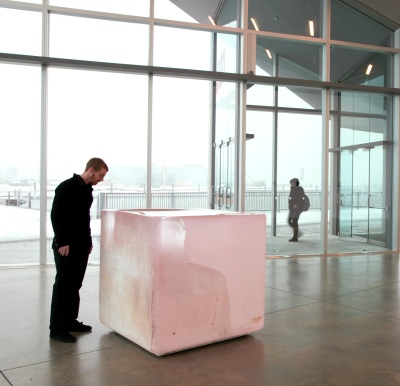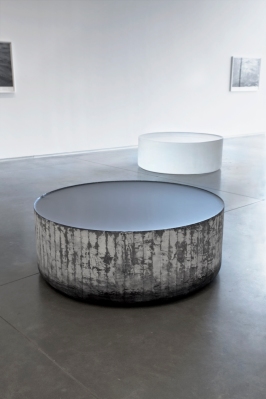 Roni Horn, Pink Tons, 2008. Solid cast glass. H 48, W 48, D 48 in. courtesy: the artist and hauser & wirth © roni horn. photo: john kennard
Roni Horn, Pink Tons, 2008. Solid cast glass. H 48, W 48, D 48 in. courtesy: the artist and hauser & wirth © roni horn. photo: john kennard
Conceptual artist Roni Horn is known for using sculptural materials to play with the viewer’s perception. Her current show “Roni Horn aka Roni Horn,” opens today at the Institute of Contemporary Art in Boston, and includes photography, drawing, and metals such as copper and gold. But the most dramatic pieces are her massive glass castings.
Horn worked with Schott, a German glass company, to fabricate the three castings on display. Two shallow cylindrical castings, Opposite of White v1 (2006), and Opposite of White v2 (2006), are clear and black castings respectively. Measuring 56 inches in diameter and 20 inches high, each casting contains about 4,500 pounds of solid glass.
The surfaces of the pieces are fire-polished and slightly bowed like liquid under tension, while the sides maintain the rough texture of the mold. The black casting is completely impenetrable to light, and its dark glass mass has a dense and heavy quality. Its polished surface is opaque but reflective, keeping any light from entering the volume of the piece.
 Installation view of "Roni Horn aka Roni Horn" at the ICA/Boston: Opposite of White, v. 1 (Large), 2006-2007, Solid cast glass, H 20 in., D 56 in.; Opposite of White, v. 2 (Large), 2006-2007. Solid cast glass. H 20, D 56 in. courtesy: the artist and hauser & wirth © roni horn. photo: john kennard
Installation view of "Roni Horn aka Roni Horn" at the ICA/Boston: Opposite of White, v. 1 (Large), 2006-2007, Solid cast glass, H 20 in., D 56 in.; Opposite of White, v. 2 (Large), 2006-2007. Solid cast glass. H 20, D 56 in. courtesy: the artist and hauser & wirth © roni horn. photo: john kennard
The clear casting, in contrast, is optically pristine and the viewer can see straight to the bottom of it. Although the immense weight of the glass is obvious, this object confuses the senses because its looks almost immaterial. At first glance the two castings seem to be opposites of one an other, but their identical title, The Opposite of White, challenges the viewer to reconsider this assumption.
Weighing about 10,000 pounds, Pink Tons (2008) is a 4-foot pink cube which the viewer might have to stand on their toes to get a good view of. The pink glass is totally transparent, and the interior of the casting has giant cracks which refract and reflect light. Looking though the surface, into the depths of the casting, you can examine the cracked glass and understand the vulnerability in the otherwise stolid structural mass.
In her New York Times review of the show as it was installed at the Whitney Museum in New York City, Roberta Smith observes, that Pink Tons and Opposite of White “quietly exaggerates the Minimalist taste for unadulterated materials to the point of flamboyance. “ Although Horn uses Minimalist geometric forms, the natural characteristics of the glass, such as the surface tension and the cracks, speak more to the phenomenology of the material.
It’s apparent from the title of the show, “Roni Horn aka Roni Horn,” as well as many interviews with Horn, that her androgynous identity is at the root of her work. The Opposite of White v1 and v2, exposes a false polarity (just as male and female are false polarities), while Pink Tons uses subtle gender signifier (such as “feminine” pink color, and “masculine” cube shape) to create an androgynous object. If Horn is attempting to expose the nature of androgyny, glass may be the perfect vehicle. Appearing as a liquid but existing as a solid, it’s atomic structure is an anomaly in the basic laws of states of matter. Horn uses the fundamental characteristics of glass to make sculpture which is visually and technically magnificent. Seen in the wider context of her work, it has an even richer meaning.
“Roni Horn aka Roni Horn,” has gained critical acclaim exhibited at both the Tate Modern in London, and the Whitney Museum of American Art in New York City. Whether you are a fan of her work or not, these castings are not to be missed.
—Kim Harty


